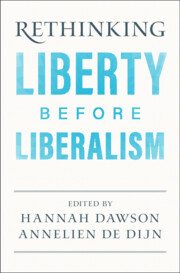Book contents
- Rethinking Liberty before Liberalism
- Rethinking Liberty before Liberalism
- Copyright page
- Dedication
- Contents
- Figures
- Contributors
- Acknowledgements
- Introduction
- Part I Authors
- Part II Hierarchies
- 4 Liberty and Hierarchy in Milton’s Revolutionary Prose
- 5 Democratic Republicanism in the Early Modern Period
- 6 Gender, Liberty, Participation, and Virtue
- 7 Liberty, Death, and Slavery in the Age of Atlantic Revolutions, 1770s–1790s
- Part III Traditions
- Conclusion
- Bibliography
- Index
5 - Democratic Republicanism in the Early Modern Period
from Part II - Hierarchies
Published online by Cambridge University Press: 22 February 2022
- Rethinking Liberty before Liberalism
- Rethinking Liberty before Liberalism
- Copyright page
- Dedication
- Contents
- Figures
- Contributors
- Acknowledgements
- Introduction
- Part I Authors
- Part II Hierarchies
- 4 Liberty and Hierarchy in Milton’s Revolutionary Prose
- 5 Democratic Republicanism in the Early Modern Period
- 6 Gender, Liberty, Participation, and Virtue
- 7 Liberty, Death, and Slavery in the Age of Atlantic Revolutions, 1770s–1790s
- Part III Traditions
- Conclusion
- Bibliography
- Index
Summary
This chapter aims to recover a specific intellectual tradition, a tradition that I describe as ‘democratic republicanism’.I do so by focusing on four different early modern thinkers: Johan and Pieter de la Court, Baruch Spinoza and Jean-Jacques Rousseau. I show that they were all part of the broader republican tradition unearthed by Quentin Skinner. But, as this chapter shows as well, the De la Courts, Spinoza, and Rousseau differed from English republicans such as Harrington and Sidney in that they were more democratic (which is, of course, why I call them ‘democratic’ republicans). They were more democratic, first and foremost, in a very straightforward way: they were in favour of a relatively inclusive political regime that they themselves described as ‘democracy’. But I will also show that they were more democratic in a second and perhaps less obvious sense of the word, in that they were committed to majoritarianism, to the idea that freedom could only be preserved if the people – which meant, in the absence of unanimity, the majority of the people – was allowed to rule without restraint.
Keywords
- Type
- Chapter
- Information
- Rethinking Liberty before Liberalism , pp. 100 - 116Publisher: Cambridge University PressPrint publication year: 2022
- 2
- Cited by

